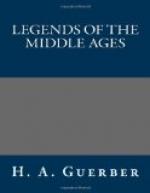The poem “Gudrun,” which is probably as old as the Nibelungenlied, and almost rivals it in interest, is one of the most valuable remains of ancient German literature. It consists of thirty-two songs, in which are related the adventures of three generations of the heroic family of the Hegelings. Hence it is often termed the “Hegeling Legend.”
[Sidenote: Kidnaping of Hagen.] The poem opens by telling us that Hagen was the son of Sigeband, King of Ireland, which was evidently a place in Holland, and not the well-known Emerald Isle. During a great feast, when countless guests were assembled around his father’s hospitable board, this prince, who was then but seven years of age, was seized by a griffin and rapidly borne away.
“Young Hagen, loudly crying,
was filled with dire dismay;
The bird with mighty pinions soared high with
him away.”
Gudrun
(Dippold’s tr.).
The cries of the child, and the arrows of Sigeband’s men at arms, were equally ineffectual in checking the griffin, which flew over land and sea, and finally deposited its prey in its nest on the top of a great cliff on a desert island. One of the little griffins, wishing to reserve this delicate morsel for its own delectation, caught the boy up in its talons and flew away to a neighboring tree. The branch upon which it perched was too weak to support a double load, however, and as it broke the frightened griffin dropped Hagen into a thicket. Undismayed by the sharp thorns, Hagen quickly crept out of the griffin’s reach and took refuge in a cave, where he found three little girls who had escaped from the griffins in the same way.
[Sidenote: The three maidens.] One of these children was Hilde, an Indian princess; the second, Hildburg, daughter of the King of Portugal; and the third belonged to the royal family of Isenland. Hagen immediately became the protector of these little maidens, spending several years in the cave with them. He ventured out only when the griffins were away, to seek berries or shoot small game with a bow which he had made in imitation of those he had seen in his father’s hall.
Years passed by before Hagen found the corpse of an armed warrior, which had been washed ashore during a storm. To appropriate the armor and weapons for which he had so long and vainly sighed was the youth’s first impulse; his second was to go forth and slay the griffins which had terrorized him and his little companions for so many years. The griffins being disposed of, the young people roamed about the island at will, keeping a sharp lookout for any passing vessel which might convey them home. At last a sail came in sight! Hagen, the first to see it, climbed up on a rock and shouted with all his young strength to attract the crew’s attention.
“With might young Hagen shouted,
and did not cease to shout,
Howe’er the roaring tempest the wild waves
tossed about.”
Gudrun
(Dippold’s tr.).




